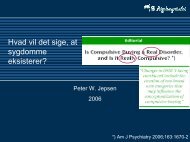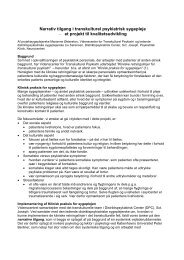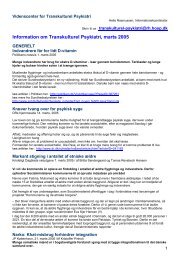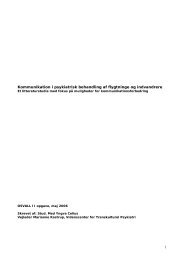Information om Transkulturel Psykiatri, marts 2009 - Videnscenter for ...
Information om Transkulturel Psykiatri, marts 2009 - Videnscenter for ...
Information om Transkulturel Psykiatri, marts 2009 - Videnscenter for ...
You also want an ePaper? Increase the reach of your titles
YUMPU automatically turns print PDFs into web optimized ePapers that Google loves.
<strong>Videnscenter</strong> <strong>for</strong> <strong>Transkulturel</strong> <strong>Psykiatri</strong>. <strong>Psykiatri</strong>sk Center København<br />
Helle Rasmussen, <strong>In<strong>for</strong>mation</strong>skoordinator<br />
Objective<br />
To examine the magnitude of past-year DSM-IV substance-related disorders (alcohol, marijuana, cocaine,<br />
inhalants, hallucinogens, heroin, analgesic opioids, stimulants, sedatives, and tranquilizers) among<br />
adolescents of white, Hispanic, African American, Native American, Asian or Pacific Islander, and multiple<br />
race/ethnicity.<br />
Design<br />
The 2005 to 2008 National Survey on Drug Use and Health.<br />
Setting<br />
Academic research.<br />
Participants<br />
Noninstitutionalized household adolescents aged 12 to 17 years.<br />
Main Outc<strong>om</strong>e Measures<br />
Substance-related disorders were assessed by standardized survey questions administered using the audio<br />
c<strong>om</strong>puter–assisted self-interviewing method.<br />
Results<br />
Of 72561 adolescents aged 12 to 17 years, 37.0% used alcohol or drugs in the past year; 7.9% met criteria<br />
<strong>for</strong> a substance-related disorder, with Native Americans having the highest prevalence of use (47.5%) and<br />
disorder (15.0%). Analgesic opioids were the second most c<strong>om</strong>monly used illegal drugs, following marijuana,<br />
in all racial/ethnic groups; analgesic opioid use was c<strong>om</strong>paratively prevalent among adolescents of Native<br />
American (9.7%) and multiple race/ethnicity (8.8%). Among 27705 past-year alcohol or drug users, Native<br />
Americans (31.5%), adolescents of multiple race/ethnicity (25.2%), adolescents of white race/ethnicity<br />
(22.9%), and Hispanics (21.0%) had the highest rates of substance-related disorders. Adolescents used<br />
marijuana more frequently than alcohol or other drugs, and 25.9% of marijuana users met criteria <strong>for</strong><br />
marijuana abuse or dependence. After controlling <strong>for</strong> adolescents' age, socioecon<strong>om</strong>ic variables, population<br />
density of residence, self-rated health, and survey year, adjusted analyses of adolescent substance users<br />
indicated elevated odds of substance-related disorders among Native Americans, adolescents of multiple<br />
race/ethnicity, adolescents of white race/ethnicity, and Hispanics c<strong>om</strong>pared with African Americans; African<br />
Americans did not differ fr<strong>om</strong> Asians or Pacific Islanders.<br />
Conclusions<br />
Substance use is widespread among adolescents of Native American, white, Hispanic, and multiple<br />
race/ethnicity. These groups also are disproportionately affected by substance-related disorders.<br />
Archives of general psychiatry 68(11), 1176-1185, 2011<br />
The role of migration in the development of depressive sympt<strong>om</strong>s among Latino<br />
immigrant parents in the USA<br />
Ornelas, India J.; Perreira, Krista M.<br />
Nearly one out of every four children in the US is a child of immigrants. Yet few studies have assessed how<br />
factors at various stages of migration contribute to the development of health problems in immigrant<br />
populations. Most focus only on post-migration factors influencing health. Using data fr<strong>om</strong> the Latino<br />
Adolescent Migration, Health, and Adaptation Project, this study assessed the extent to which pre-migration<br />
(e.g., major life events, high poverty), migration (e.g., unsafe and stressful migration experiences), postmigration<br />
(e.g., discrimination, neighborhood factors, family reunification, linguistic isolation), and social<br />
support factors contributed to depressive sympt<strong>om</strong>s among a sample of Latino immigrant parents with<br />
children ages 12–18. Results indicated that high poverty levels prior to migration, stressful experiences<br />
during migration, as well as racial problems in the neighborhood and racial/ethnic discrimination upon<br />
settlement in the US most strongly contribute to the development of depressive sympt<strong>om</strong>s among Latino<br />
immigrant parents. Family reunification, social support, and familism reduce the likelihood of depressive<br />
sympt<strong>om</strong>s.<br />
Social science and medicine 73(11), 1169-1177, 2011<br />
Stressors related to immigration and migration background in Turkish patients with<br />
psychiatric disorder : validity of a short questionnaire (MIGSTR10)<br />
Müller, Matthias Johannes; Koch, Eckhardt<br />
9






